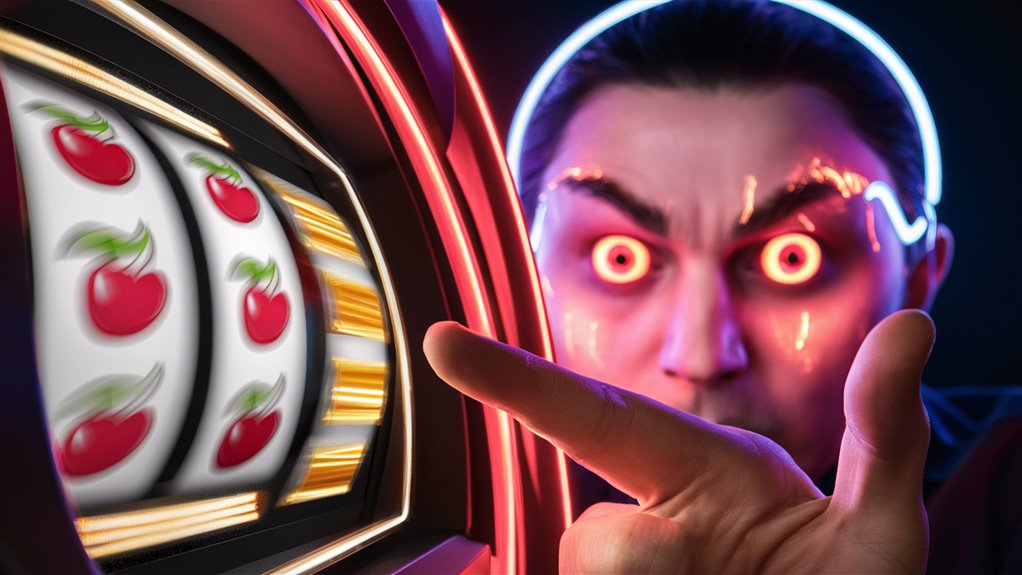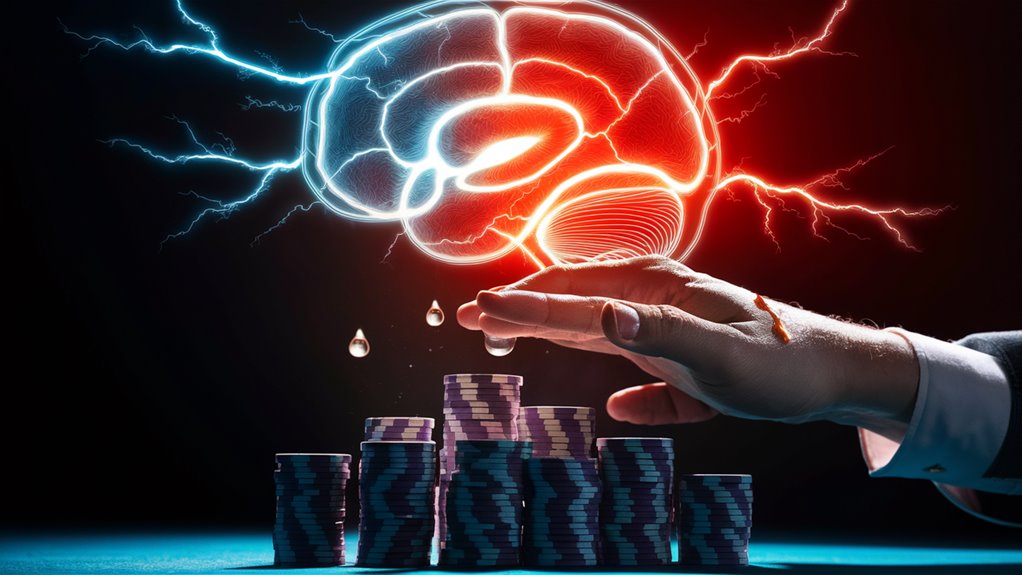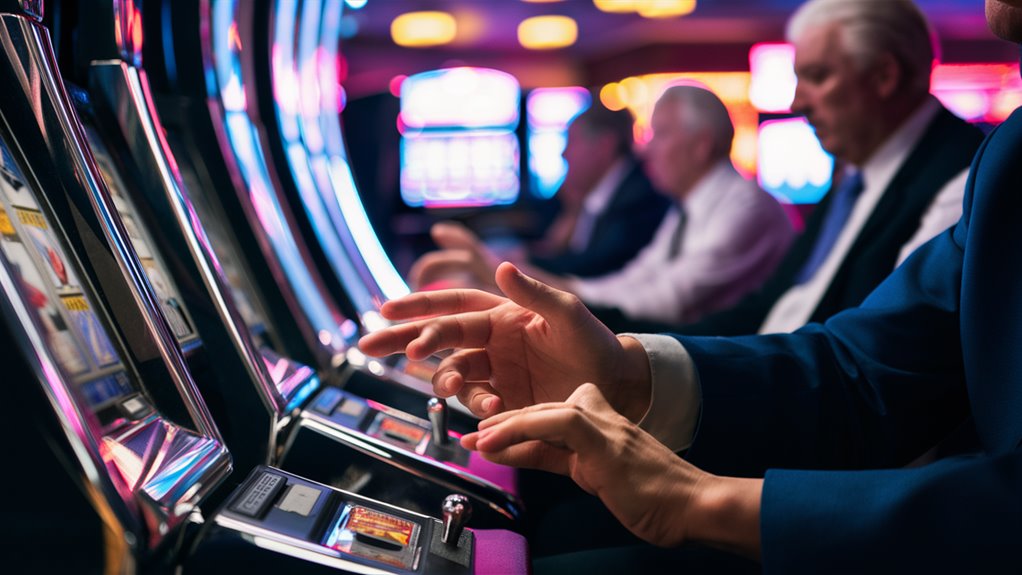The Science Behind Gambling: Why We Keep Coming Back

The science of gambling addiction shows why we find betting hard to stop. When someone bets, their brain’s reward system changes a lot, mainly by making dopamine in the nucleus accumbens areas. This strong chemical change happens not just when they win, but also when they almost win or lose, as the mesolimbic pathway keeps being active with uncertainty.
How Gambling Affects the Brain
The brain acts like it does to drugs when someone gambles. The D2 receptors get used to it with more gambling, making the person need bigger risks to feel a buzz. This makes powerful feedback loops in the brain’s reward parts, pushing the gambling behavior with deep brain changes.
Knowing the Addiction Cycle
The dopamine system’s reaction to unsure bets makes it hard to stop. This goes deeper than just willpower, as the brain’s reward paths change a lot with more gambling. The brain processes behind gambling keep a strong need and pleasure cycle going, like other habits.
Choices and Gambling
These brain changes mess up how we make choices, as the brain’s reward parts start to focus more on gambling. The mix of dopamine and changed 온카스터디 안전업체 보기 brain paths drives us to keep gambling, even when it hurts us. Knowing these brain parts helps make better treatments and ways to stop gambling from starting.
The Dopamine Effect
The Dopamine Dance: Knowing the Brain Science of Gambling
Brain’s Reward Parts in Action
When you pull a slot machine or place a bet, the brain’s reward parts light up right away. The nucleus accumbens, the pleasure spot, makes dopamine – key for reward and wanting to do things. This brain action happens a lot in the wait before we know if we win.
Brain’s Reaction to Almost Winning
The brain’s dopamine part treats near-wins and real wins almost the same. This makes an on-and-off reward plan, where almost-wins make dopamine even though you lose. Through this, the brain stays into gambling, making us want to play more from these strong chemical reactions.
How Dopamine Changes
The tie between gambling and dopamine follows a complex pattern of brain changes. With regular gambling, the brain changes how dopamine works, lowering normal levels over time. This brain change needs riskier bets to get the same dopamine effect. The higher need for thrill shows the move from just gambling to not being able to stop, as people look for bigger dopamine rushes.
Main Brain Effects:
- Reward path action
- Dopamine release patterns
- Brain changes
- Behavior loops
- Risk and reward balance
Dangers and Rewards in the Brain
Knowing the Brain Paths of Risk and Reward
Fundamental Brain Facts on Gambling
The complex link between risk and reward in the brain sets the gambling action base. Two main brain paths drive this: the reward path focused on the nucleus accumbens and the risk part led by the amygdala. These parts talk a lot through complex signals.
Important Brain Areas and What They Do
When gambling, the front brain works hard, figuring out possible rewards and dangers. The bottom part of the front brain makes dopamine before wins, while the insula handles unsure results. The front outer brain mixes all this, figuring out risks and rewards.
Molecules and Brain Chemicals
At the molecule level, serotonin helps handle risk want, while adrenaline boosts focus on rewards. The brain’s main control center, the front brain, tries to control these urges but can be overrun by strong brain chemical waves. This chemical take-over shows why gambling keeps going even as losses pile up, as the risk and reward circuits are taken over by these strong signals.
Changing Rewards in Action
Understanding Changing Rewards in Gambling

The Brain Science of Betting
Changing rewards show a deep brain process that makes dopamine affect our want for rewards even more. This shapes betting acts through deep brain paths. When results are not sure, dopamine cells stay very active, making stronger reactions than with sure rewards.
Brain During Gambling
The nucleus accumbens, a key reward spot, sees big dopamine jumps during many gambling times. These jumps happen not only during wins but also during almost wins and waiting times. This unsure reward plan causes much stronger brain reactions compared to set reward plans. The bottom brain part keeps making dopamine even during losses, keeping the hope of future wins alive.
Brain Learning and Behavior
The mesolimbic pathway, a survival learning system, responds more to unsure gambling results than sure rewards. This makes changing rewards very strong in keeping gambling going. The natural learning paths turn towards gambling, creating strong habits through dopamine action.
Main Impact Points:
- Dopamine during unsure outcomes
- Brain paths during betting
- Reward system through changing rewards
- Behavior staying the same through brain changes
Stopping the Addiction Loop
Stopping the Addiction Loop: A Brain Look
Knowing the Brain Parts of Gambling Addiction
Getting free from gambling’s deep brain hold needs breaking the set dopamine paths. This looks at certain brain parts that keep addiction acts going. When gambling, the brain’s reward part gets very sensitive to betting signs while getting less responsive to normal pleasures.
Three Main Brain Fixes
1. Dopamine Part Reset
Not betting for 60-90 days lets D2 parts get normal, lowering dopamine action and bringing back usual joy acts.
2. Normal Reward System Fix
Doing joy-making acts like:
- Moving a lot
- Being with others
- Staying mindful
These raise serotonin and happy hormones levels, making the brain’s reward system better.
3. Stopping Need Circuits
Stopping glutamate-driven need paths needs:
- Knowing what sets off gambling
- Making ways to not act on these signs
- Building new acts
Brain Change and Getting Better
Thought and behavior fixing helps change the brain by reconnecting reward wait to no gambling acts. The brain’s ability to change lets new, healthier paths form through steady work and practice. This planned way looks at both acts and brain parts of getting better, pushing real change through proven science paths.
Brain Science of Betting
The Brain Science of Betting Behavior: Knowing Gambling’s Impact on the Brain
Brain Parts Behind Gambling
Today’s brain science shows complex brain acts behind betting, where dopamine changes make strong behavior loops. The brain’s reward system acts to gambling through certain brain chemicals that shape how we make choices and assess risks. How Gambling Can Influence Your Financial Future
Dopamine and Reward
During betting, the nucleus accumbens fills with dopamine, giving a rush before we know the result. The lower front brain acts the same during almost wins as real wins, making dopamine that pushes us to keep betting through deep brain loops.
Brain Paths and Addiction
Checking Risks and Choices
The front brain handles odds and risks, though these can get worse with more gambling. The emotion part of the brain is more active during betting choices, while the front middle brain controls urges.
Long-term Brain Changes
Long gambling changes brain paths, mainly lowering D2 dopamine parts like drug habits. This makes a need for more risks to feel the same buzz, making a cycle of more intense betting acts.
